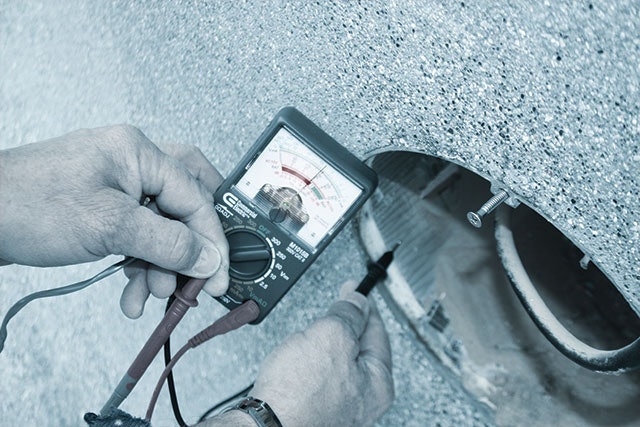From
How To Test Pool/Marina Grounding and Bonding Grid
Checking the Swimming Pool Electrical System to Ensure that It’s Safe from Electrical Shock
CAUTION: Before you go any further, you must understand electrical fundamentals, the concept of neutral-to-earth, and the bonding requirements contained in the NEC. Visit
Mike Holt Enterprises - the leader in electrical training., watch the three videos listed, download and print my PDF document on Article 680 of the National Electrical Code.
1. Bonding System Inspection. Do a visual review of the pool bonding system and note all equipment that needs to be tested to ensure that it’s properly bonded such as:
- Pool pump motors
- Heat pump
- Salt chlorinator
- Hand rails that make contact with water.
- Hand rails that do not make contact with water.
- Pool lights if they are metal
2. Verify that all metal parts are bonded to the service neutral. Measure the resistance between the meter socket enclosure, service equipment, or grounding electrode conductor to all metal parts of the electrical system and pool that are required to be bonded. The resistance that is measured should be no more than one ohm (after the meter has been recalibrated to account for the resistance of wire used for the measurements). If the resistance from the service neutral to any metal part is not less than one ohm, then you must investigate why and this must be corrected.
Note: I suggest you use an analog multimeter such as a Tekpower TP7244L, with the resistance setting of X1.
3. Verify that a concrete pool shell is bonded to the service neutral.* First determine the Neutral-to-Earth voltage by placing one lead of the volt meter to the meter socket enclosure, service equipment, or grounding electrode conductor, and the other lead to a point in the earth that is at least 15 ft from any metal parts in the earth. This voltage reading should be less than 3 volts. Now measure the voltage between the meter socket enclosure, service equipment, or grounding electrode conductor to the water in the pool at four different locations. If the voltage is zero at all locations, then this means that the pool shell steel is bonded to the electrical system. If your volt reading is not zero, then you need to contact Mike Holt at
[email protected] on how to proceed further.
Note: I suggest you use an analog multimeter such as a Tekpower TP7244L, with the voltage setting of 10V.
4. Verify that the perimeter decking around the pool is bonded to the service neutral.* First determine the Neutral-to-Earth voltage by placing one lead of the volt meter to the meter socket enclosure, service equipment, or grounding electrode conductor, and the other lead to a point in the earth that is at least 15 ft from any metal parts in the earth. This voltage reading should be less than 3 volts. Measure the voltage between the meter socket enclosure, service equipment, or grounding electrode conductor to the perimeter decking to at least six points (6, 12, 18, 24, 30, and 36 inches from the pool water) at two locations around the pool. If the voltage reading should be near zero volts, and not the measured neutral-to-earth voltage.
Note: I suggest you use an analog multimeter such as a Tekpower TP7244L, with the voltage setting of 10V.
Ensure NEC Compliance
Remove the covers from all equipment (service disconnect, panels, time clocks, pool light transformers, pool light junction boxes, switch boxes, pool motors, heat pump motors, etc.) that is related to the pool system in any way. TURN OFF POWER BEFORE YOU REMOVE COVERS.
Inspect the wiring within all equipment to ensure that all wiring is Code compliance;
- Are the conductors sized properly for the loads?
- Does each circuit have proper overcurrent protection?
- Does each conductor terminate on to a single terminal?
- Torque all conductor terminals to manufactures instructions.
- Has an equipment grounding conductor been run to all equipment?
- Is the equipment grounding conductor, when of the wire type sized properly?
- Ensure that the neutral conductor is not in contact with the equipment grounding conductor except at service equipment.
- Covers are installed and have proper fit for all enclosures.
- What is the voltage rating of the light(s) in the pool.
As electrical-related pool accidents spike, it's imperative that pool pros check the safety of their pool wiring. Here's a simple way to do so.

www.aquamagazine.com


